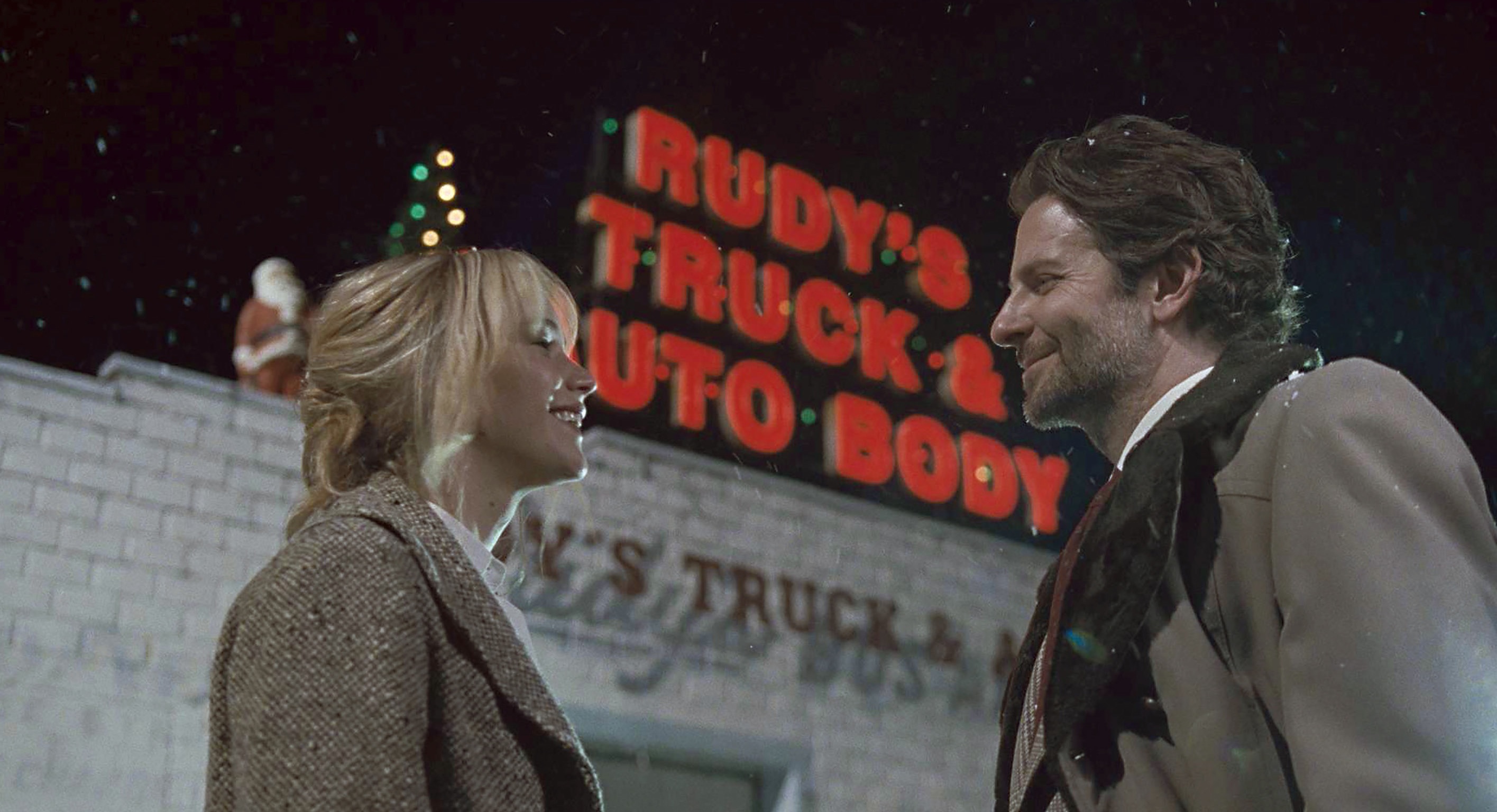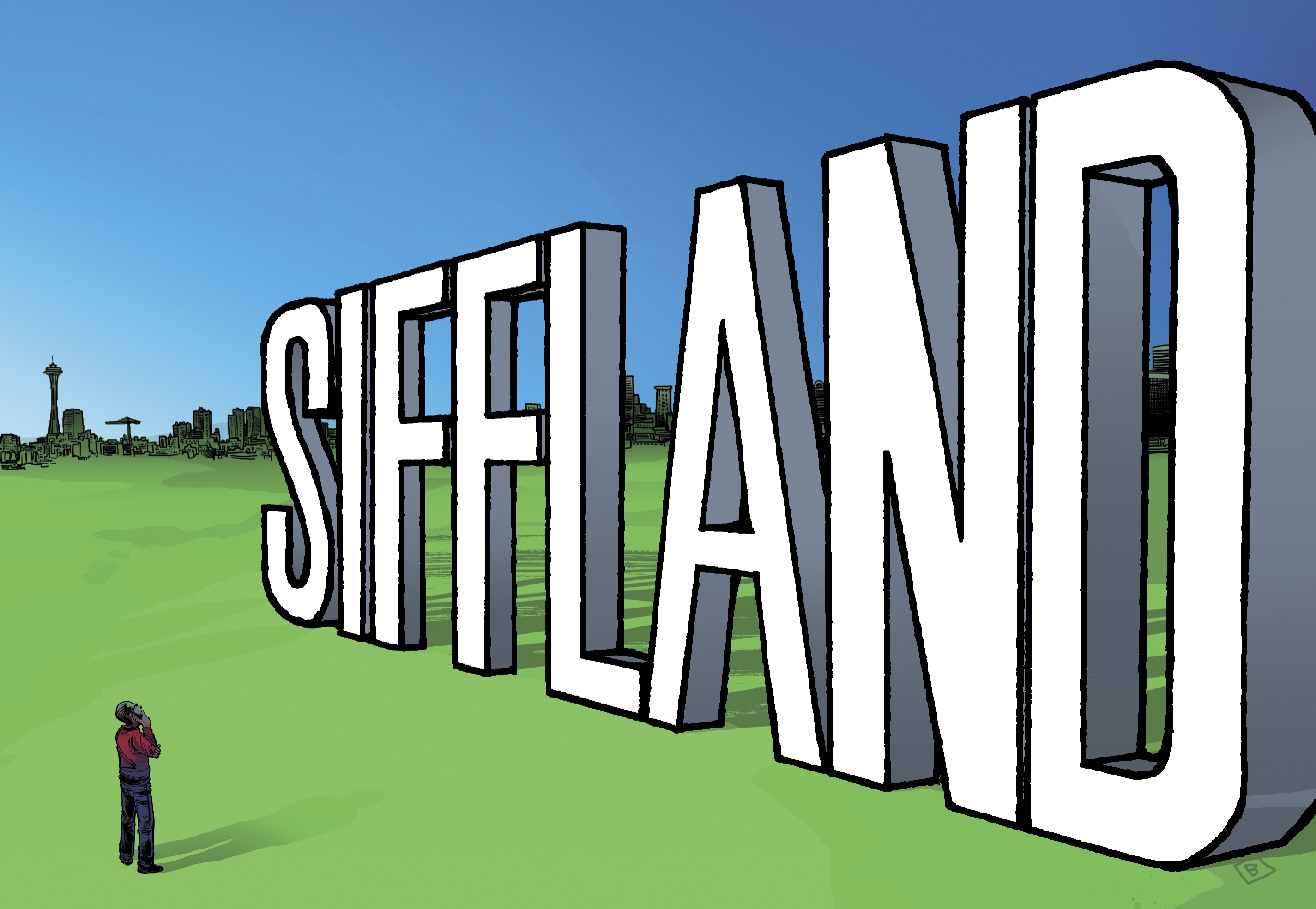Much has been written about the proliferation of tacky town houses and shoddy, high-priced condos in Seattle, as if they had cornered the market on bad taste. But if you actually examine our far greater supply of single-family homes, as SW has done in a far-ranging field study, that privileged ideal falls victim to a less flattering taxonomy. Just as an entomologist pins beetles in a display case, so can we also delineate and describe the varied and uniquely hideous species of ugly Seattle houses, as follows below with selected illustrations.
The FAR-monster
Floor-area ratio (FAR) relies on arcane formulas best understood by architects, rocket scientists, Mensa members, Charles Mudede, and planners at Seattle’s Department of Planning and Development (or DPD, an acronym that will recur maddeningly below). The easiest way to understand FAR is that, whatever the size lot next to you, your neighbor has got way, way too much FAR—and you should probably place an anonymous call to the DPD to get his ass investigated.
The classic monster house or “megahouse” is bloated with FAR. What was once a cute, 1,000-square-foot Wallingford bungalow is scraped to the foundation, has its basement excavated for wine cellar and home theater, then vomits itself perpendicularly toward the sky with nary an eave, taper, gable, dormer, or softening of right angles. The FAR-monster is a math-fed beast. Each square inch is justified by lot size and the DPD’s maximum permitted height. To build anything less would be to leave money on the table!
It’s all about numbers, the owner reasons: Since I paid and am being taxed so much on this land, I might as well max out my investment, balloon my mortgage, and supersize my potential return when I eventually sell. If the neighbors complain, if small children are frightened, if the designer chickens owned by the lesbians next door stop laying eggs, to heed those concerns would allow them to steal my money! They would be drinking my milk shake! Drinking it up!
There is no architectural hallmark of the FAR-monster, no signature style. Its aesthetic is size—an SUV without wheels, a venti coffee without froth, a galvanized bucket brought to the all-you-can-eat buffet. Some allude to Federal or Tudor with appliqué bricks or turrets; some try to pass off painted C-board as international modernist; a few even belt themselves with tiny porches (sized to park a few strollers) in a gesture toward the Craftsman houses whimpering next door. But no one is fooled. The FAR-monster cannot change its stripes—or rather, the spreadsheet columns and rows that constitute its genetic code.
The Misfit
Listening to the Tom Waits song “What’s He Building?” will help you understand the Misfit. The owner—and it’s always a he—never comes out in daylight hours. He might’ve built the house himself, or inherited it from a crazy old bachelor uncle who never married and shot at the neighborhood dogs with a BB gun. No one knows his name. There is no mailbox, only a shattered, rotting timber where it used to stand—as if something explosive came by first-class delivery.
The Misfit itself is the opposite of contextual or background architecture. It’s the glaringly broken tooth in a row of stucco Alki bungalows or manicured Maple Leaf Tudors or tidy View Ridge ranchers. It’s the house where your real estate agent steps on the gas, redirecting your attention to the cute little number on the other side of the street. It’s the address where the UPS man, newspaper boy, and doorbelling Mormons won’t enter the yard. It’s the property where even neighborhood dogs won’t go to crap or pee, as if some instinctual, self-preserving part of their canine brain keeps them away.
If the neighbors are shingled, the Misfit is tin. If others on the block favor an indigenous color scheme of sand, salal, and fir, the Misfit will be industrial orange, with glossy black trim. If your community association favors tasteful, ecumenical holiday decorations in December, the Misfit inexplicably lights up during solstices and foreign holidays. If cedar siding surrounds the Misfit, that house is clad in crumbling asbestos shingles whose particles whirl and eddy in the wind. And no matter what the prevailing taste of the neighbors, the Misfit’s design always incorporates concrete blocks, blue tarps, garages converted to living quarters (or home laboratories; no one is certain which), corrugated plastic paneling, uncovered tar paper, uncovered, untreated plywood, and old Ron Paul yard signs.
You may have solar panels on your roof to help power your plug-in hybrid. The Misfit has a working oil derrick in the backyard. You may drive the kids to school in an old Mercedes wagon converted to biodiesel. In the Misfit’s driveway, there’s an Eastern European jalopy of uncertain vintage and branding that runs on coal, grain alcohol, or potato scraps—depending on the old rationing scheme of the Soviet Bloc. Your windows are triple-glazed and energy-efficient. The Misfit uses an elaborate system of Saran Wrap and cardboard. You compost your food waste out back and use the worm-enriched product for fertilizer. The Misfit has a perpetually smoldering 55-gallon oil drum.
There is a canoe on the roof, just in case. The front fence is made of stacked, hardened old bags of concrete. The sibilant table saw in the garage can be heard always running, running, running. What, at first glance, appear to be tacky ornamental lawn animals are, when inspected with binoculars, actual taxidermic specimens. There are eight satellite dishes on the roof, all of them working. Sometimes the cellar door—yes, there is a cellar; the Misfit is tornado-ready even if you aren’t—inexplicably flies open with a whooshing sound and burst of acetylene light, then slams shut again as if by its own hand.
The Pig Face
Also known by architects as the Snout House, this dwelling thrusts its two-car garage toward the street like a greedy sow rooting for rotten vegetables. There is no yard, just a couple of anorexic saplings flanking its maw. No one who lives there has ever been seen to enter or exit on foot. (You’re not sure if the owners even have feet.) The garage bay doors gape open and shut to swallow assorted minivans, SUVs, motor homes, ATVs, motorcycles, dune buggies, Segways, Jet Skis, and snowmobiles.
The rest of the Pig Face is curiously quiet, an appendage to its nerve center. The garage is how it thinks, breathes, and functions; it is an orifice directed at the world, its primary sensory organ, the snake’s tongue and cat’s whiskers.
When it snows in winter, the path to the front door is untracked, but the driveway is always swept clear (or heated from below).
Like their porcine cousins, Snout Houses tend to cluster in herds, on blocks of new, spec-built tract homes without alleys for garage parking in back. In fact, no one knows what the backs of these houses look like. They’re all front, all face, always nudging closer to the street, as if they, too, crave movement and mobility. If they could drive themselves to Costco, then motor up and down the aisles, they would.
The Trophy Home (aka The Angelina Jolie)
Found in your more premium Seattle neighborhoods (Washington Park, North Capitol Hill, Windermere, the Highlands, etc.), the Angie manages to outshine even her most expensive rivals on the block. It doesn’t matter if they were designed or remodeled by name architects; they become the dowdy girls at the dance who, by contrast, make the Angie’s special glow that much more alluring.
How does she do it? Why is the lawn so much greener, the driveway always dewy wet and sparkling in the sunshine, the yard so well tended (seemingly without déclassé leaf blowers or unsightly, undocumented labor), the cherry trees in season a little sooner? Her roof is never mossy, her gutters never full.
It’s not just the money. Her neighbors all have the funds for titanium roofs, Italian hand-quarried marble countertops, and clear-grain cedar siding. It’s just that the Angie presents her opulence so much better. It’s like gold dust is mixed in with the paint pigments, the furniture is stuffed with the hair of blond, 8-year-old Austrian farm children (all of them humanely shorn!), and the air inside enriched with extra oxygen (is it being piped in?). The floors don’t squeak when you walk on them. There’s always a gentle breeze caressing your neck. You can hear the babbling of the courtyard water feature in every room.
The Angie herself may not be ugly. But something about her unnatural collagen-lipped, silicone-breasted architecture arouses ugly feelings of resentment and suspicion. Her perfection can’t be real, can’t be the result of a normal birth between architect, client, and interior decorator (who functions, in this cause, like a doula).
Also, the Angie is trying too hard. There are showier houses, larger and more vulgar houses, houses that are merely garish and nouveau riche. But the Angie bludgeons us with good taste—and, in the process, devalues the very idea of it, threatens our appreciation of it.
Then, after you’ve been invited to tour the Trophy Home, or perhaps been over for an Obama fund-raiser cocktail party, when one perfect Rogue’s Spruce gin martini led to perhaps three or four, and you allowed yourself to sink deeper into that seductive couch full of Austrian farm-children hair, it feels like you’ve cheated on your own house, been seduced by the Angie.
And, in a horrible way, you liked it.
The Appalachian
Not to be confused with the Misfit, which at least has an organizing aesthetic principle at work, here the basic design tenets are secretiveness, contempt for community standards, an inbred resistance to book learning, parole violations, home detention, and crystal meth.
The Appalachian is hostile to nature—hence the paved-over yard—yet indifferent to the creeping urban kudzu of broken-down cars, discarded beer coolers, old refrigerators, metal bed frames (with burnt shards of mattresses still attached), and forlorn children’s bicycles (though no kids reside in the house) that surrounds the place.
The architectural method here is a process of reduction to essentials. Its ethos is decay. Its hallmark is a refusal to pay bills, answer the doorbell (two protruding wires, actually), do routine maintenance, or let the dogs out to pee.
House fires are a signature element of the Appalachian, all of them calmly extinguished by garden hose, the rusted sprinkler still attached. But the authorities are never, ever called. Whether caused by cigarette smoking in bed, on the couch, in the shower, or while working on an outboard boat engine in an old, water-filled oil drum, these small, regular blazes give a charcoal patina to the Appalachian. Tyvek and two-by-fours are nailed over the damage, and woe to the inquisitive opossum that squeezes through the plastic to investigate; these marauders are never seen again. (In truth, another advantage to having the Appalachian as a neighbor is that there’s always someplace convenient to have your chain saw sharpened.)
Other telltales include: automotive paint and Bondo used to patch the facade after a police chase leads to a high-speed “parking” maneuver by the house; the pile of old propane canisters out back; wiring connected to the nearest street lamp; and motorcycles parked indoors. And, of course, all the windows are covered with tinfoil.
The Bauhaus Bunker
When Al Qaeda drops the big one, we know which house on the block will be left standing. Sometimes referred to as the International Brutalist style or the Bastard Son of Mies (or sometimes simply “the Dieter”), the Bauhaus Bunker is always built and designed by an architect who has no other private residential commissions in town. Instead, his firm—with a mostly international clientele—is noted for designing parking garages, hockey arenas, airport terminals, and NORAD facilities.
Proud, unadorned concrete is the hallmark of the Bauhaus Bunker. There is a purity to the hard yet malleable substance that those who don’t speak German as a first or second language will never be able to appreciate; they cannot see the beauty of the Kunst-Idee wrested from man-made Baumaterialien. The austerity is only softened by the occasional protruding I-beam, steel window shutters, and opaque glass curtain walls. There are no trees or flowers to compromise the intellectual rigor of the design. A small plot of lawn seems to tend itself, as if frightened to grow any taller.
The place contains no wood or natural materials, as if it were allergic to them. There are no drapes on the windows. (Privacy is not a concern for the owners, with their close-cropped gray hair and steel-rimmed spectacles, who are androgynous nudists in their 50s fond of wearing only wool socks with nonslip soles.) There is no garbage or recycling left by the curb. The Bauhaus Bunker never needs painting, of course, and its tidiness becomes severity, almost a form of aggression.
The street address for the Bauhaus Bunker always includes the numeral 7, and that numeral is always rendered as the European 7. Its dimensions and ratios are perfect. (Perfect!) All angles are right. All floors are perfectly level; when you drop a drafting pencil on the floor—meine Liebchen!—it stays perfectly in place without rolling. Doors close soundlessly on titanium hinges. Its square footage is actually rendered in square meters, and that figure ends in a zero. There are no stray decimal points, no uncoiled garden hoses, no blue New York Times bags strewn by the front door.
Everything has been precisely calibrated and calculated in the Bauhaus Bunker. It wears its math on the outside. The rest of you wouldn’t understand.
The Green Zone Special
Warning! Warning! You are walking too close to this property! The police have been called! Once considered indigenous only to Baghdad and Kabul, or the province of Colombian drug lords and Eastside software barons, the maximum security compound is steadily taking hold in Seattle. We are, after all, a global city, and that means global threats. Why should your family be any less safe than a U.N. delegation or the Lagos bureau of CNN? Who knows what threats lurk in the undergrowth of Laurelhurst or Madison Park? Is there any reason to believe Al Qaeda doesn’t have access to Google, that they might not be tracking your kids after soccer practice, that the violent predators of America’s Most Wanted don’t also thrive in the Pacific Northwest?
Why take that chance?
The Green Zone Special doesn’t. And the beauty is that unsightly blast walls and razor wire are no longer required to keep infiltrators and undesirables off your property. Swing gates with intercom boxes are the hallmark of the high-walled GZS, but the security doesn’t stop there. Armored glass windows never open, even in summer. The whole compound is ringed by motion-sensor lights. Unmarked security patrol vehicles pass by regularly, driven by uniformed men with coiled earphones. Marauding midnight raccoons have been known to elicit helicopter searchlights. Delivery men are instructed to leave their packages out front, then back away very, very slowly, with hands visible.
Sometimes, when walking the dog past, you notice the red light of a laser spotting scope on your chest (or that of your pet). If a newspaper or errant ball is lobbed over the wall, it’s incinerated midflight. Inside, the savage barking of guard dogs can be heard. There is no street address on the house, no family name indicated. Online, the property tax records have been redacted. Should you wish to speak with the owners about a PTA meeting or a tree that’s dropping leaves into your yard, you must submit your questions in writing to an attorney.
Architecturally, beyond a reliance on concrete, steel, and clear firing lines, the Green Zone Special is distinguished by metal roll-down window shutters and safe rooms with separate and redundant lines for electricity, water, and oxygen. It’s got driveway space for an entire motorcade of armored Hummers.
The FU-ADU
First regulators allowed the ADU (Accessory Dwelling Unit), or “mother-in-law apartment,” designed to help relieve housing pressures in areas of the city zoned single-family. Then came the DADU (Detached Accessory Dwelling Unit), which resulted in backyard cottages in designated areas of Seattle. More recently, a tight rental market and ballooning mortgage payments have quietly given rise to the FU-ADU, which gives the middle finger to neighbors and DPD planners alike. One day, where a carport, fruit tree, or children’s sandbox previously stood, a cheap, squat, C-board-encased cashbox appears. Its purpose is not to please or ingratiate. It is there to produce revenue, no matter what the leafy concerned citizens of Wallingford, Bryant, or Fauntleroy might think. White vinyl gutters run like engorged veins off the tar-poured roof. The fixtures come from Home Depot, the construction labor from the parking lot of Home Depot, the permits from…well, there aren’t any permits.
Do you miss the sound of children playing on the swing set, the smell of hamburgers cooking at neighborhood barbecues, the gentle thwacking of the shuttlecock during summer badminton tournaments?
Well, then, you obviously don’t know a goddamn thing about real estate values, or you’d already have a FU-ADU of your own. And, mark my words, you will.
The Encroacher
Lot line? What lot line? The Encroacher is the equivalent of the close talker in Seinfeld. One summer evening you walk around the side of your house to coil the garden hose, when you think, “WTF, did the fence just get closer—or is it the neighbors’ entire house?!?” After all those remodels, their house sure looks different. But could it have actually moved on its foundations?
Suddenly your own home is shadowed by the Encroacher during all seasons of the year. Its windows now peer directly into your bedroom, bath, and kitchen. Squirrels no longer have to traverse the power lines between houses but leisurely bound across the short gap between roofs. Your Wi-Fi network always asks you first if you’d like to join the Encroacher, and you wonder if its inhabitants are monitoring your e-mail. Your TiVo records its shows. The UPS man forces you to sign for its packages. Your Wall Street Journal always gets tossed onto its porch. There’s no place to park anymore on the street.
More than once, you’ve been roused from bed by the reassuring grinding of the coffee mill and aroma of fresh French Roast, the sound of children chattering and the dog’s feet pattering on the hardwood floors, when you realize, “This is not the morning routine of our happy home. This is the deception of the Encroacher!”
Yet city surveys, old property maps, and Google Earth provide no confirmation. The Encroacher just seems larger, more overbearing, and uncomfortably intimate. Loomier, if one may use that word. It’s a psychic as well as a physical projection. The FAR-monster is bulky and steroidal, obvious in its gross demands for space. The Encroacher insinuates, creeping across the property line of your brain, into your very dreams. It ruins your marriage, alienates you from your kids. It’s the architectural Iago, a conniver, a malign whisperer whose voice keeps getting closer, closer, closer….
This is why, in nine cases out of 10, unhappy owners next door to an Encroacher ultimately opt to move. It’s also why they invariably sell to greedy town house developers, with this final request: “Just make them as ugly and as close to the neighbors as possible.”
The Never-Ending Remodel
No one can remember when it began. No one knows when, if, it will end. What was once Tudor, maybe, has since transitioned through Mediterranean Revival, International style, shingled bungalow, pseudo Gothic, and to its present state—which no one can identify beneath the scaffolding and tarps. (Unless it’s late-period Frank Gehry.)
Contractors will no longer bid on the job. Architects don’t return phone calls from the owners. DPD inspectors have taken early retirement rather than add to the stack of appeals and violations. The front-yard sign where permits are stapled has itself been on the block longer than some houses. Only the carting company that regularly drops off and retrieves its truck-bed Dumpsters bothers to send Christmas cards.
The yard, meaning piles of dirt, is held in place against the rain by an elaborate lattice of garden plastic, old tires, and rope. Local children use it as a BMX course during the afternoons.
The owners of the NER, bank account run dry, triply mortgaged, IRAs cashed out early, both with second jobs at Target and Starbucks, have now taken to doing most of their own renovations. Late at night, flashlights and nail guns are busily employed behind the wind-whipped plastic. (The rest of the house is dark, as if the power has been shut off.) In the morning ghostly footprints of Sheetrock dust lead to where the cars are parked. The owners have become zombies, prisoners of their NER, lost in the maze of blueprints and permits.
They can’t remember what they wanted, can’t predict where the project is going. But perhaps the next shelter mag in the mailbox will give them a new idea to follow….
For a slideshow of ugly Seattle houses—and to submit your own candidates!—go to www.seattleweekly.com.








